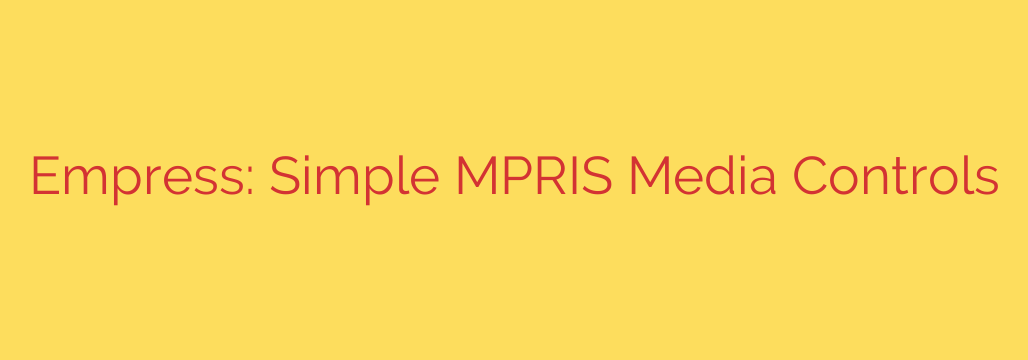
Empress: The Minimalist Command-Line Tool for Linux Media Control
For those who live and breathe in the Linux terminal, switching to a graphical interface just to pause a song or skip a track can feel like a frustrating interruption. Managing media players often requires leaving your focused command-line environment. Fortunately, a sleek and powerful solution exists for this exact problem: Empress, a minimalist command-line tool designed to give you full control over your media without ever leaving the terminal.
If you value efficiency, minimalism, and scriptability, this lightweight utility might be the perfect addition to your workflow.
What is Empress?
Empress is a simple, fast, and intuitive CLI (Command-Line Interface) tool for controlling media players on Linux. It works by communicating with any media player that supports the MPRIS D-Bus Interface Specification. In simpler terms, it acts as a universal remote control that you operate directly from your terminal.
Whether you’re using Spotify, VLC, Audacious, or another compatible player, Empress provides a unified way to manage playback. Its core strengths include:
- Lightweight and Fast: Written in Rust, Empress is incredibly performant and has a negligible memory footprint, making it ideal for any system, especially minimalist setups.
- Simple Syntax: The commands are straightforward and easy to remember, such as
play-pause,next,previous, andstop. - Highly Scriptable: Its command-line nature makes it perfect for integration with custom scripts, keyboard shortcuts, and status bars.
Understanding the Power of MPRIS
The magic behind Empress is MPRIS (Media Player Remote Interfacing Specification). Think of it as a standardized language that most modern Linux media players agree to speak. This protocol allows different applications—like your desktop environment’s media keys or a tool like Empress—to send commands such as “play,” “pause,” and “what song is this?” to any player that understands the standard.
By leveraging MPRIS, Empress avoids the need for player-specific plugins or complex configurations. It simply sends standardized messages, and any compatible player will respond accordingly.
Getting Started: Installation and Basic Commands
Installing Empress is incredibly simple, especially if you have the Rust programming language’s toolchain and its package manager, Cargo, installed on your system.
To install, just run the following command in your terminal:
cargo install empress
Once installed, you can immediately start controlling your media. Open your favorite MPRIS-compatible music player (like Spotify) and try these commands:
- Toggle Play/Pause:
empress play-pause - Skip to the Next Track:
empress next - Go to the Previous Track:
empress previous - Stop Playback Completely:
empress stop
Advanced Usage: Unlock Your Workflow’s Potential
While the basic commands are useful, the true power of Empress is unlocked when you integrate it into your daily workflow. Here are a few practical examples of what you can achieve.
1. Create Custom Keyboard Shortcuts
Most Linux window managers (like i3, Sway, or bspwm) and desktop environments (like GNOME or KDE) allow you to bind commands to key combinations. You can easily set up your own media keys to execute Empress commands.
For example, in an i3 window manager configuration, you could add:
bindsym XF86AudioPlay exec empress play-pause
bindsym XF86AudioNext exec empress next
bindsym XF86AudioPrev exec empress previous
This gives you tactile, system-wide media control powered by a simple, reliable tool.
2. Integrate with a Status Bar
Empress can also fetch metadata about the currently playing track, making it perfect for display in status bars like Polybar or Waybar. You can retrieve the artist, title, album, and more.
For instance, to get the current artist and title, you can use the format flag:
empress metadata --format '{{ artist }} - {{ title }}'
You can then write a simple shell script to periodically run this command and pipe the output to your status bar, giving you an elegant “Now Playing” widget. This is a fantastic way to create a customized and informative desktop experience.
3. Script Complex Actions
Because Empress is a command-line tool, you can incorporate it into any shell script. You could write a script that automatically pauses your music when you start a video call, logs your listening history to a text file, or even changes your smart lighting based on the playing track’s metadata. The possibilities are limited only by your imagination.
In conclusion, Empress offers a powerful, efficient, and highly customizable solution for managing media on Linux. For terminal enthusiasts, developers, and anyone seeking to streamline their workflow, it provides a crucial link between the command line and media playback. Give it a try to reclaim full, uninterrupted control over your digital environment.
Source: https://www.linuxlinks.com/empress-mpris-media-controls-made-simple/








